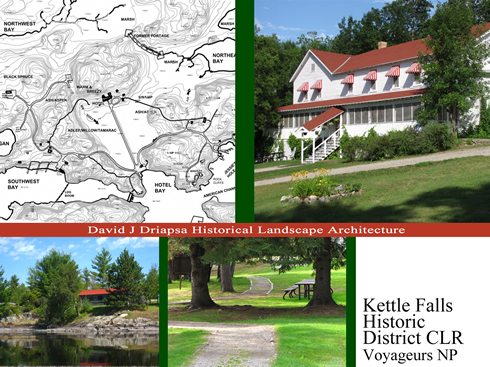
The Wilderness Community of Kettle Falls
Voyageurs National Park, Minnesota
U.S. National Park Service
The General Management Plan for Voyageurs National Park written in 2002 included the development of 15-20 visitor destinations. These destinations can be reached only by boat and provide visitors with an opportunity to learn about this national park and its significance.
David Driapsa master planned boat docks, accessible trails, picnic facilities and interpretive wayfinding exhibits for these destinations that include historic structures and cultural landscapes being preserved by the National Park Service.
This project meets the provisions of Sections 106 and 110b of the National Historic Preservation Act, requiring federal agencies to produce documentation to HALS standards on sites that are listed in the National Register of Historic Places to mitigate the adverse effects of federal actions such as demolition or substantial alteration.
The work was conducted by David Driapsa serving as project director for Voyageurs National Park Division of Resources Management. He prepared master plans for numerous historic sites in the park, including the Kettle Falls Historic District. Each site has an ADA accessible boat docks, paths, comfort station, picnic tables and interpretative signage. David compiled archival information and site reconnaissance documenting the existing historic landscape, architectural and archeological resources and developed the master plan document. The site is accessible by water craft and float planes.
The master plan assesses existing natural and cultural resources and recommends site organization to enhance visitor experience, interpretation, and programming. Management of resources and ADA accessibility are critical issues that are addressed, presenting present short- and long-term goals by which the Park Service can meet both goals of accessibility and preservation.
The Kettle Falls Historic District is located within the Kettle Falls developed area. Kettle Falls has been a crossroad of travel for hundreds, perhaps thousands of years. People of different periods −− Ojibwe, voyageurs, loggers, and recreational users −− traveled through, lived in, and used the natural resources of the area. The historic Kettle Falls Hotel is concession-operated. The Kettle Falls Dam represents the contending visions of industrialist Edward Wellington Backus and conservationist Ernest Oberholtzer about the future of the area as well as nationwide issues about conservation. The Kettle Falls Historic District is a large area with multiple historic, natural, and recreational features, access points, and types of visitors. It is a popular visitor destination and the only lodging available in the park.
Kettle Falls has been a portage area as long as people have used the boundary lakes for travel. The falls were
known to American Indians, early fur traders, explorers, gold miners, commercial fishermen, and loggers who had
to portage around this transportation barrier when traveling between Namakan and Rainy lakes. There have been
accommodations at Kettle Falls since the late 1890s. Kettle Falls Hotel was constructed in 1910. Construction of the
dams at Kettle Falls and Squirrel Falls on the Canadian side were completed in 1914.